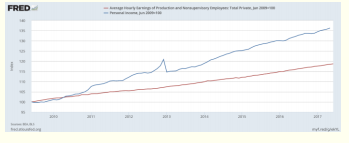Central Banks are slowly waking up to the fact that they cannot fix structural economic issues. In fact, evidence from the great monetary experiment of the last decade, indicates that they probably enhance them. The real economic problem is growing income inequality. Real economic growth is dependent on middle class consumption, and absent real wage growth, this consumption becomes ever more dependent on debt financing. While aggregated debt metrics for the U.S. consumer don’t seem to be overly-inflated, when you consider the burgeoning federal debt load issued for bloated entitlement spending, and the leverage of lower income families, a different picture emerges. By artificially lowering interest rates, Central Banks across the world enable governments to subsidize the structural problem of income inequality that they have failed to correct.
Central Banks cannot increase real growth over the long-run. Easy-money has benefited corporate buybacks, enabled the leveraged purchase of assets, and produced a wealth effect. However, it has not increased productivity, and has increased income inequality.

Figure 1- Since 2009, Personal Income which includes rental income, proprietor income, and wages has increased much more than wages for production and non-supervisory employees. Easy money drives income inequality.
Prior to the last recession, many economists believed that lower rates incentivize business investment. This never came to fruition, and thus never matriculated into the real economy. Businesses wait for robust revenue growth to invest in both capital and their workforce. Unfortunately, revenue growth is dependent on middle class wage growth, a cohort whose marginal propensity to consume is much higher than that of the upper class. Central Banks are starting to realize that future economic growth is reliant much more on fiscal initiatives than the Fed Funds rate.

Figure 2 – Low rates spur domestic investment, right? Nope.
If you are wondering why the Federal Reserve is intent on rising rates in the face of subdued GDP growth and low inflation, it is because they realize the sterility of monetary policy in the face of low productivity, subdued wage growth, and low inflation. Policy normalization, meanwhile, provides them with the dry powder they need to perform their true function—to be the lender of last resort in times of crisis. If raising rates into weakness doesn’t make sense, it’s because you think that the Federal Reserve, in this environment, matters. It doesn’t.











Leave A Comment